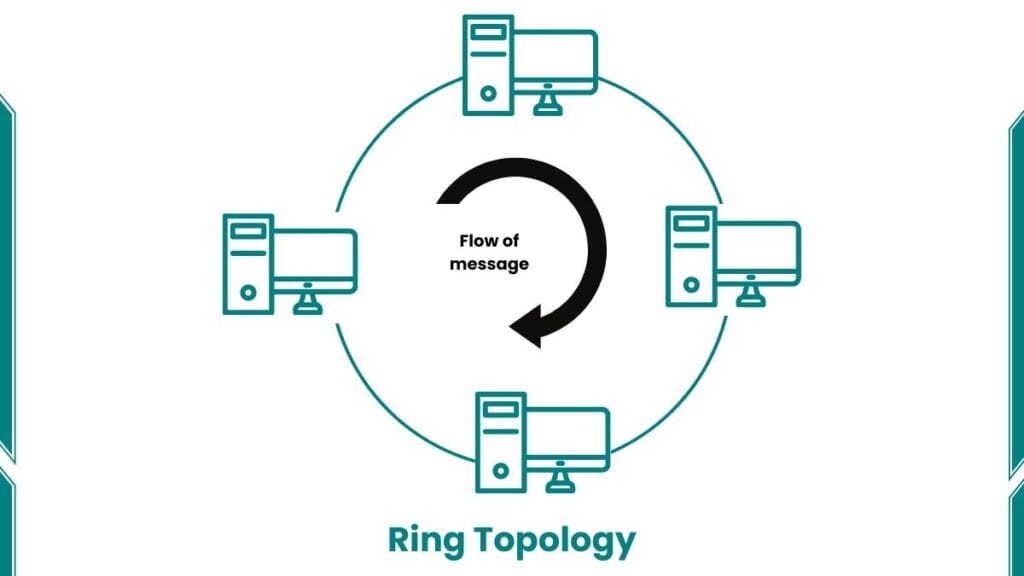A ring network is also referred to as ring network topology. It is a distinctive configuration in computer networking where each device connects to exactly two other devices, forming a circular pattern. This arrangement creates a closed loop. It allows data to travel in a single direction around the network.
Ring Network Definition
A ring network is a type of computer network where each device connects to two neighboring devices, creating a circular path for data to travel. This means information passes through each device on the network one after another.

Features of Ring Topology
- Circular Structure: Devices in a ring topology are arranged in a closed loop, resembling a circle or ring.
- Unidirectional Data Flow: Information typically travels in one direction, either clockwise or counterclockwise, around the ring.
- Equal Access: Each node in a ring network has an equal opportunity to transmit data, preventing any single device from monopolizing network resources.
- Token-Based Transmission: Many ring networks use a token-passing mechanism for data transmission, where a special packet (token) circulates the network, granting permission to transmit data.
- Point-to-Point Connections: Each device in the ring connects directly to its two neighboring devices, creating a series of point-to-point links.
Types of Ring Network
Here are Ring network types:
- Single Ring: The most basic form of ring topology. It consists of one circular path for data transmission.
- Dual Ring: A more advanced configuration featuring two concentric rings. This setup provides increased reliability and fault tolerance by offering an alternate path if one ring fails.
- Switched Ring: Incorporates switching technology to improve performance and allow for more flexible data routing within the ring structure.
Advantages of Ring Topology
Here are some ring topology benefits:
- Equal Access: The ring network design ensures that no single node can monopolize network resources, promoting fair usage.
- Predictable Performance: Data transmission times are consistent due to the sequential nature of the ring, making it easier to estimate network performance.
- Easy to Install and Reconfigure: Adding or removing nodes from a ring network is relatively simple, requiring only two connections to be modified.
- Fault Isolation: Problems in the network can be easily located and addressed, as each node actively monitors the health of the network.
- No Central Point of Failure: Unlike star topologies, ring networks don’t rely on a central hub, potentially improving reliability.
Disadvantages of Ring Topology
Here are some drawbacks:
- Single Point of Failure: A break in the ring or failure of a single node can disrupt the entire network, though dual-ring configurations can mitigate this issue.
- Complexity in Troubleshooting: Identifying issues may require checking each node sequentially, which can be time-consuming in large networks.
- Latency: Data must pass through each node in the ring, potentially causing delays in large networks or when transmitting large amounts of data.
- Limited Scalability: Adding many nodes to a ring network can decrease overall network performance due to increased latency.
- Bandwidth Limitations: The entire network shares a single communication channel, which can become a bottleneck in high-traffic scenarios.
Ring Computer Network Applications
- FDDI (Fiber Distributed Data Interface): High-speed networks using fiber optic cables, often used for backbone networks in large organizations.
- SONET (Synchronous Optical Networking): Used in telecommunications for long-distance data transmission over fiber optic networks.
- Small Office Networks: Suitable for organizations with a limited number of devices that require equal access to network resources.
- Industrial Control Systems: Some industrial networks use ring topologies for their predictable performance and fault tolerance capabilities.
Ring Network Settings
Ring topology in computer networks can be implemented in various settings:
- Local Area Networks (LANs): Commonly used in small to medium-sized organizations for connecting devices within a limited area.
- Metropolitan Area Networks (MANs): Employed in larger geographical areas like cities, connecting multiple LANs or buildings.
- Token Ring: A specific implementation of ring topology using token-passing technology, once popular in enterprise networks.
- Fiber Distributed Data Interface (FDDI): A high-speed network ring topology using fiber optic cables, often used for backbone networks.
